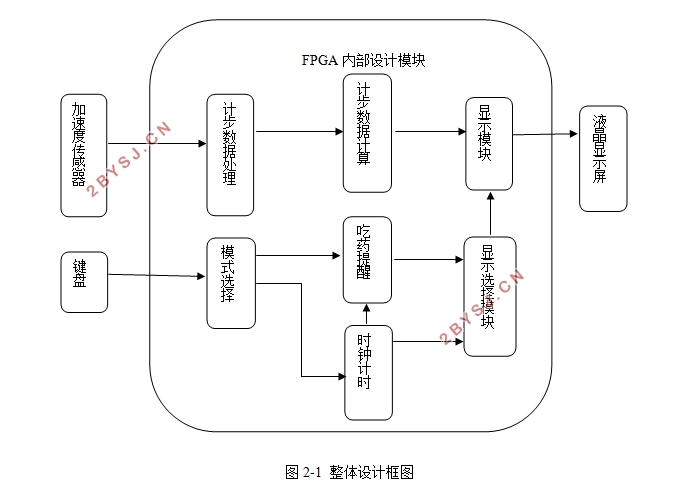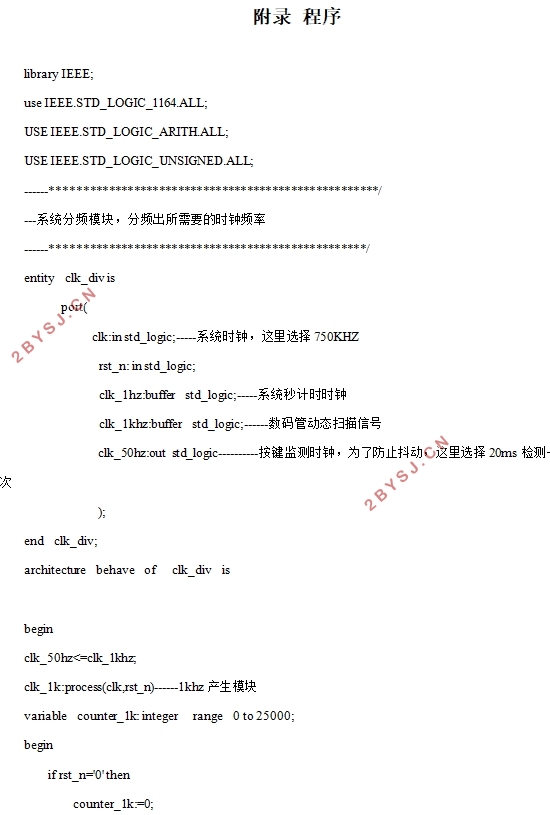基于FPGA的计步器的设计
无需注册登录,支付后按照提示操作即可获取该资料.
基于FPGA的计步器的设计(论文12200字)
摘要
由于现代社会的快节奏生活,给人们生理上带来巨大压力,越来越多的人开始重视起自己的健康状况,而走路,跑步又是一种简单有效的锻炼方式,于是计步器应求出现。
本文采用FPGA设计一款计步器,实现电子钟,吃药提醒及计步功能,本文实现计步功能主要通过加速度传感器。人在行走过程中会产生一个加速度,加速度传感器通过感受人行走产生的加速度,来判断人行走动作的发出,从而实现计步功能,本设计同时具有计时、提醒功能。
本文采用开发板,使用VHDL语言,实现了计时功能,在数码管上显示出时间进度。通过对吃药间隔时间的设置,使用蜂鸣器来设置吃药提醒。通过对加速度传感器的数据处理,在数码管上显示人行走的步数。
关键词:计步器 电子钟 吃药提醒
The pedometer based on FPGA
Abstract
Because of the fast pace of life in modern society , bring great pressure on people's lives, more and more people begin to pay attention to their health, and walking, running is a simple and effective way to exercise, So pedometers exists.
This paper mainly use the FPGA to achieve the electronic clock, medication reminders and counting step function, the objective is to achieve the basic functions of general pedometer, and some exploration and research. In this paper, the function of the counting step is mainly through the acceleration sensor. People in the process of walking will produce an acceleration, acceleration sensor by feeling the acceleration generated by human walking, to judge the issue of human walking action.
This paper uses the development board, using VHDL language, to achieve the timing function, in the digital tube shows the time schedule, through the time of the medication interval settings, use the buzzer to set the medication reminder. Through the data processing of the acceleration sensor, the number of people walking display in the digital tube.
Keywords: Pedometer ; Electronic clock ; medicine reminde


目录
基于FPGA的计步器 I
摘要 I
The pedometer based on FPGA II
Abstract II
第一章 绪论 1
1.1 引言 1
1.2 计步器的国内外研究现状 2
第二章 设计总体介绍 3
2.1 设计整体思路介绍 3
2.2 相关软硬件介绍 4
2.2.1 spartan-6开发板简介 4
2.2.2 ISE软件简介 5
2.3 FPGA总体端口设计 5
第三章 计步各模块设计 7
3.1 信号采集模块 7
3.1.1 基于加速度信号的计步器原理 7
3.1.2 加速度传感器简介 7
3.1.3 加速度传感器的引脚及功能 8
3.1.4 加速度传感器的模式选择 9
3.2 计步数据处理模块 10
3.3 计步数据计算模块 11
第四章 显示设计模块 13
4.1 显示屏介绍 13
4.1.1 LCD12864特性介绍 13
4.1.2 LCD12864的管脚说明 13
4.1.3 LCD12864的显示模式 14
4.2 显示选择模块 14
4.3 显示驱动模块 16
第五章 时钟与吃药提醒模块 18
5.1 模式选择模块 18
5.2 时钟计时模块 19
5.3 吃药提醒模块 21
5.4 时钟分频模块 23
第六章 总结与期望 25
参考文献 26
致谢 28
附录 程序 29
